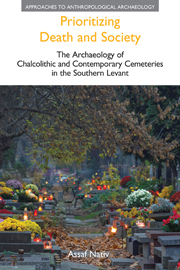 Prioritizing Death and Society
Prioritizing Death and Society Book contents
- Frontmatter
- Dedication
- Contents
- List of figures
- List of tables
- Acknowledgements
- Part I Introduction
- Part II Chalcolithic cemeteries
- Part III Contemporary cemeteries
- 10 An archaeology of us
- 11 The raw materials: from matt to lustre, from grey to colour
- 12 Tombstone morphology: communal trajectories
- 13 Tombstone elaboration: personal expressions
- 14 Spatial patterns: between institutional policy and interpersonal spontaneity
- 15 Intersecting discourses
- Part IV Conclusion
- Appendix: Gazetteers of cemeteries
- Notes
- Bibliography
- Index
15 - Intersecting discourses
from Part III - Contemporary cemeteries
- Frontmatter
- Dedication
- Contents
- List of figures
- List of tables
- Acknowledgements
- Part I Introduction
- Part II Chalcolithic cemeteries
- Part III Contemporary cemeteries
- 10 An archaeology of us
- 11 The raw materials: from matt to lustre, from grey to colour
- 12 Tombstone morphology: communal trajectories
- 13 Tombstone elaboration: personal expressions
- 14 Spatial patterns: between institutional policy and interpersonal spontaneity
- 15 Intersecting discourses
- Part IV Conclusion
- Appendix: Gazetteers of cemeteries
- Notes
- Bibliography
- Index
Summary
The previous chapters offer an overview of a selection of features and aspects that constitute contemporary cemeteries in Israel and that ultimately coalesce into two fairly distinct strands of analysis and interpretation: one pertaining to the tombstone (see Chapters 11 to 13) and the other to spatial patterning of graves (see Chapter 14). Both are marked by striking differences in content and terminology. While the tombstones were shown to embody and participate in social discourses on levels ranging from the single agent to broad societal structures, the spatial patterning inside the cemeteries revealed negotiations between institutional policy and personal demands. Yet, despite these apparent discrepancies, the tombstone and the spatial arrangement are closely linked. Most importantly, the cemetery constitutes an embodiment of a social community, and its organizing principles have considerable impact both upon its overall concept and its internal structure. Thus, for example, the representation of the community as a loose cluster of single autonomous agents is a direct result of the insistence on single burials.
Single burials and the arrangement of the graves in neat rows are the only characteristics common to all cemeteries analysed. Indeed, the data seems to emphasize that each cemetery otherwise followed its own independent course. Nevertheless, if we were to try to group the cemeteries into categories, it would be misleading to consider all aspects analysed as equally relevant. As observed throughout the foregoing chapters, diferent aspects are associated with diferent social and institutional levels.
- Type
- Chapter
- Information
- Prioritizing Death and SocietyThe Archaeology of Chalcolithic and Contemporary Cemeteries in the Southern Levant, pp. 184 - 190Publisher: Acumen PublishingPrint publication year: 2013


